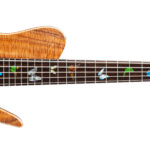If the bass guitar is the heartbeat of a band, then Bass Guitar Strings are undoubtedly the heart of the bass itself. Strings are the origin point of your instrument’s sound, vibrating to create the notes that resonate through your bass and into the music. Beyond sound, they are also the tactile interface between you and your instrument. The feel of your strings directly translates into the overall feel of your bass guitar. Choosing the right bass guitar strings is therefore a critical decision for any bassist, and fortunately, it’s one you can revisit and change as often as you like. Experimentation is key to discovering what works best for your playing style and sound.
Material Matters: Unpacking String Composition
When diving into the world of bass guitar strings, material is a primary consideration. The majority of bass strings are crafted with nickel-wrapped steel. However, variations in material can significantly alter the tonal characteristics and playing experience. A notable example of alternative materials is found in Ernie Ball’s Cobalt Slinky series. Strings like the Ernie Ball 2736 Cobalt Regular Slinky 5-String Electric Bass Strings utilize cobalt, offering enhanced flexibility, resistance to sweat and moisture, and a heightened magnetic response. This increased responsiveness makes cobalt strings particularly effective at interacting with your bass pickups, leading to a dynamic and articulate sound that many modern bassists favor. For those seeking a more traditional tone and feel, classic nickel-wound strings remain a popular choice, including other offerings within the Ernie Ball Slinky family.
Coated or Uncoated: Considering String Longevity and Feel
Another important factor to consider when selecting bass guitar strings is whether to opt for coated or uncoated varieties. Uncoated strings provide a traditional feel with excellent responsiveness and a textured surface under your fingers. Many players appreciate the direct connection and immediate feedback that uncoated strings offer. However, uncoated strings are susceptible to corrosion and wear, which can shorten their lifespan.
Coated strings, on the other hand, are designed to extend string life significantly. While early coatings were sometimes criticized for dampening the string’s sound, advancements in coating technology have largely addressed this issue. Elixir Strings, for instance, utilizes a nanoweb coating that exemplifies this progress. The nanoweb coating is applied as an incredibly thin tube around the string windings, effectively shielding the string from contaminants without penetrating the windings themselves. This design helps preserve the bright, resonant qualities of uncoated strings while providing the benefits of extended lifespan and reduced finger squeak.
Gauges and String Count: Tailoring Strings to Your Bass
Beyond material and coating, your choice of bass guitar strings must also align with your instrument’s specifications and your playing preferences in terms of gauge and string count. Gauge refers to the thickness of the strings, typically measured in thousandths of an inch. Heavier gauge strings generally produce a fuller, more powerful tone with increased sustain, but may require more finger strength and can feel less flexible. Lighter gauge strings offer easier playability and faster action but may sacrifice some low-end punch. The number of strings is dictated by your bass guitar itself – whether it’s a 4-string, 5-string, or 6-string bass. Ensure you select a string set that matches the string count of your instrument.
Once you’ve considered material, coating, gauge, and string count, you’ll find that the vast selection of bass guitar strings becomes much more manageable. From there, exploring the nuances of different brands, construction methods, and personal preferences will lead you to discover the perfect set of bass guitar strings to unlock your ideal sound and playing experience.

